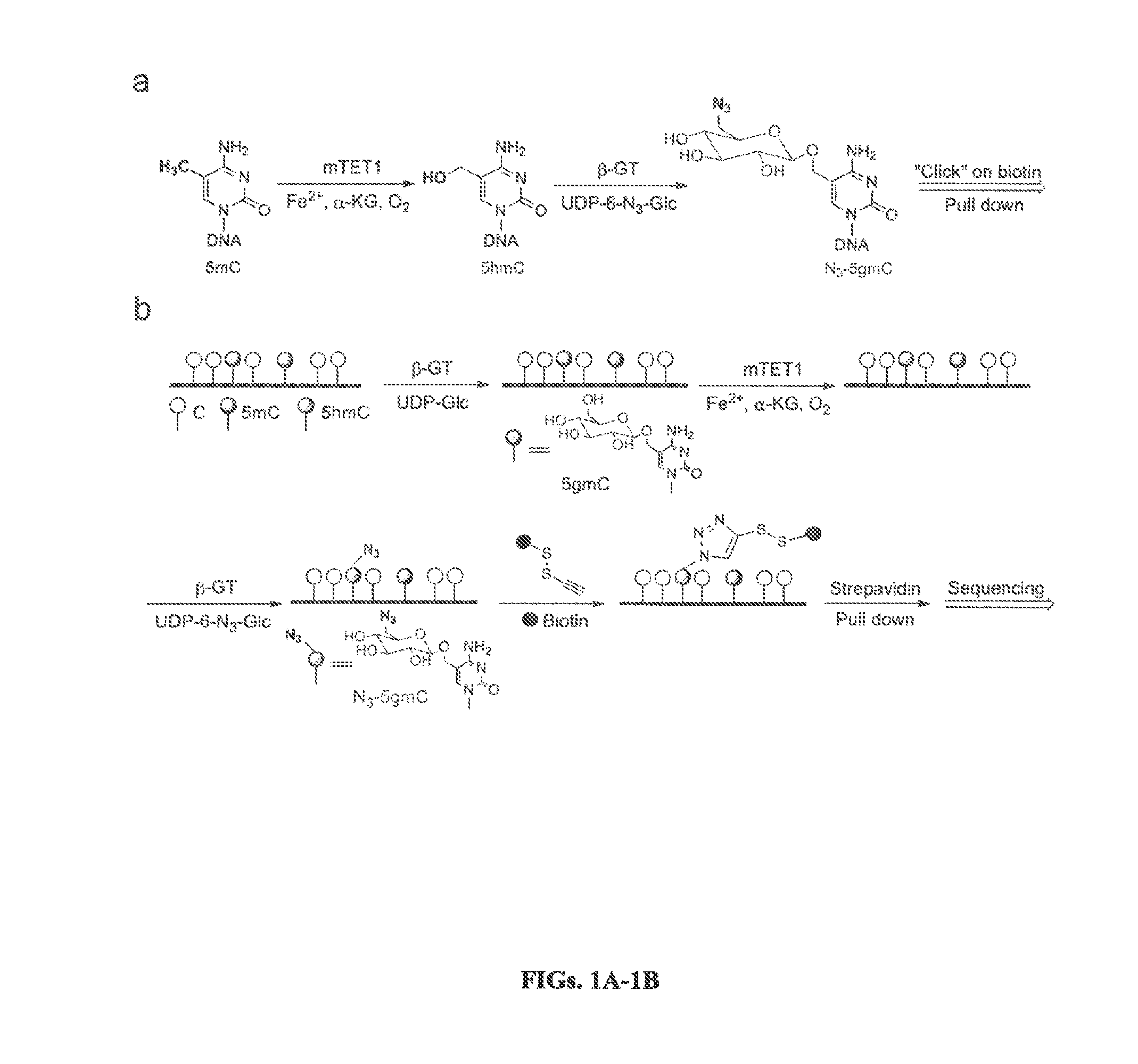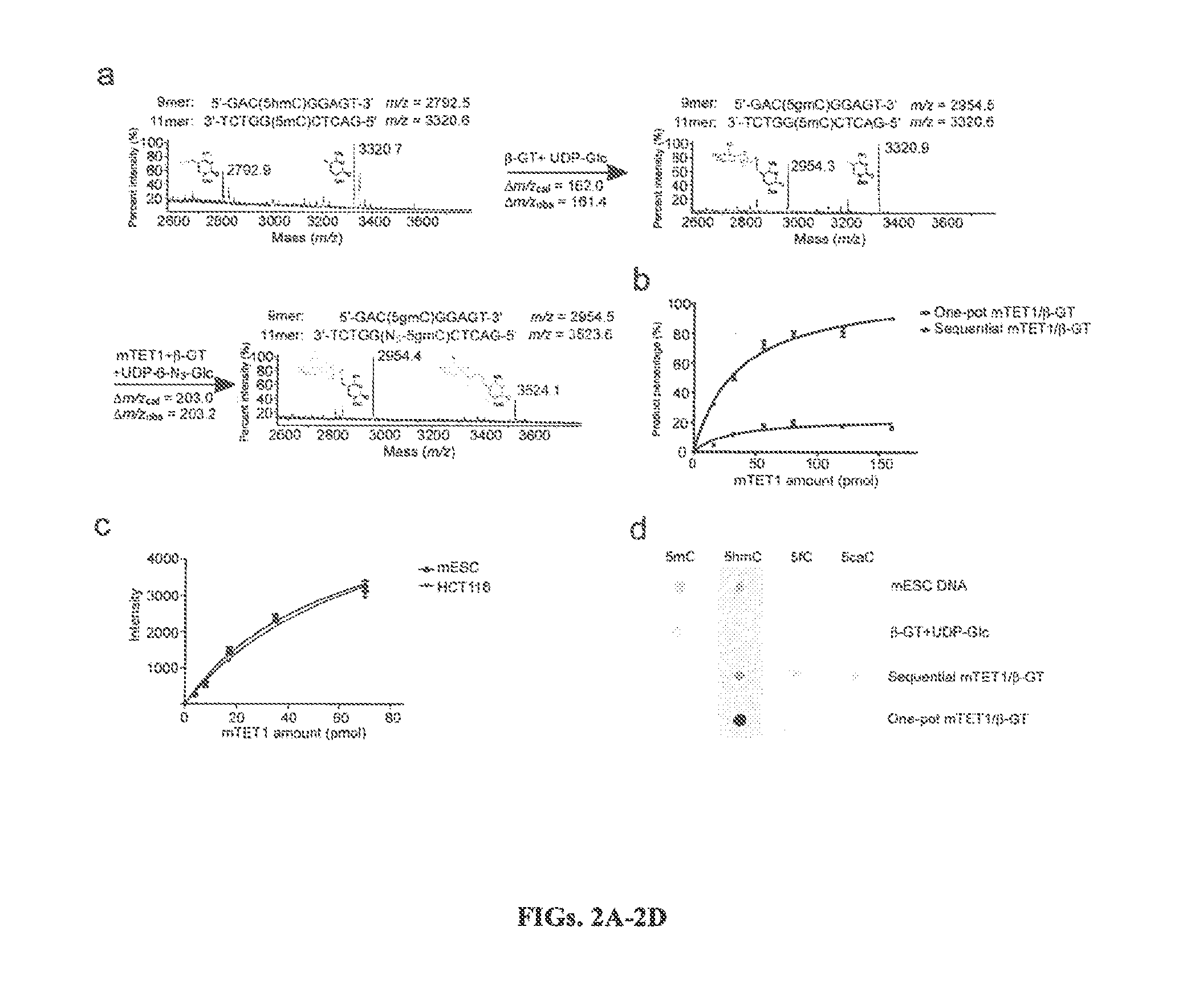COMPOSITION AND METHODS RELATED TO MODIFICATION OF 5-METHYLCYTOSINE (5-mC)
a technology of methylcytosine and methylcytosine, which is applied in the field of composition and methods related to the modification of methylcytosine (5-mc), can solve the problems of inability to easily and efficiently detect or measure 5-methylcytosine (5-mc) and/or 5-, and the profiling process has drawbacks of high cost and time-consuming, or the ineffectiveness of less densely populated 5-mc sites, and achieves high conversion efficiency.
- Summary
- Abstract
- Description
- Claims
- Application Information
AI Technical Summary
Benefits of technology
Problems solved by technology
Method used
Image
Examples
example 1
Materials and Methods
[0276]Recombinant mTET1 Expression and Purification.
[0277]The catalytic domain of Mouse TET1 (GU079948) gene was cloned into BssH1 and NotI sites of N-terminal Flag-tagged pFastBac Dual vector (Invitrogen) and expressed in Bac-to-Bac baculovirus insect cell expression system. The recombinant Flag-mTET1 (residues 1367-2039) was purified by using the published procedure (FIGS. 4a and 4b) (Ito et al., 2010).
[0278]Recombinant β-Glucosyltransferase (β-GT) Expression and Purification.
[0279]The Recombinant β-GT was expressed and purified by the protocol known in the art (Song et al., 2011).
[0280]Oligonucleotide Synthesis.
[0281]9mer, 11mer, 32mer and 44mer oligonucleotides containing single CpG with modified cytosine (5mC or 5hmC) were prepared by incorporating the phosphoramidite (5mC and 5hmC) at the desired position during solid-phase synthesis (Dai and He, 2011). The reagents and phosphoramidites (5mC and 5hmC) were purchased from Glen Research. All synthetic oligon...
example 2
[0312]In the methods described herein, all TET family proteins (TET 1, 2, 3) could be employed to oxidize 5mC to 5hmC (FIG. 7). The inventors have demonstrated that the catalytic domains of mouse TET1 (1367-2039) and TET2 protein (916-1921) display high activity in converting 5mC to 5hmC (FIG. 8). Once 5mC is converted to 5hmC, it can be labeled with biotin, quantified by Dot-blot assay, enriched by biotin beads and sequenced or detected as described herein (FIG. 9). Initial results demonstrate that 5mC contributes 0.49% while 5hmC contributes 0.06% of total nucleotides of mouse cerebellum genomic DNA.
example 3
Materials and Methods
[0313]All the bisulfite conversion and purification of DNA was accomplished using the EpiTect Bisulfite Conversion Kit (Qiagen) in which 80 ng of substrate was used. The bisulfite-treated DNA was amplified by PCR and sent for sequencing.
[0314]The TET2 oxidative reaction was carried out by incubating 150 ng substrate with 5 μg TET2 (or TET1) in 50 mM HEPES, pH 8.0, 100 μM Fe(NH4)2(SO4)2.6H2O, 1 mM α-KG, 2 mM ascorbic acid, 2.5 mM DTT, 1 mM ATP, 50 mM NaCl at 37° C. for 1.5 h.
[0315]The sequence of the 76mer 5caC-containing oligonucleotide
(SEQ ID NO: 7)5′-CCTCACCATCTCAACCAATATTATATTATGTGTATATcaCGcaCGTATTTTGTGTTATAATATTGAGGGAGAAGTGGTGA-3′
[0316]The sequence of the 76mer 5mC-containing oligonucleotide,
(SEQ ID NO: 8)5′-CCTCACCATCTCAACCAATATTATATTAmCGmCGTATATmCGmCGTATTTmCGmCGTTATAATATTGAGGGAGAAGTGGTGA-3′
[0317]Primer used for PCR after bisulfite treatment,
(SEQ ID NO: 9)Forward: 5′-CCCTTTTATTATTTTAATTAATATTATATT-3′(SEQ ID NO: 10)Reverse: 5′-TCACCACTTCTCCCTCAAT-3′
[0318]The...
PUM
| Property | Measurement | Unit |
|---|---|---|
| pH | aaaaa | aaaaa |
| pH | aaaaa | aaaaa |
| pH | aaaaa | aaaaa |
Abstract
Description
Claims
Application Information
 Login to View More
Login to View More - R&D
- Intellectual Property
- Life Sciences
- Materials
- Tech Scout
- Unparalleled Data Quality
- Higher Quality Content
- 60% Fewer Hallucinations
Browse by: Latest US Patents, China's latest patents, Technical Efficacy Thesaurus, Application Domain, Technology Topic, Popular Technical Reports.
© 2025 PatSnap. All rights reserved.Legal|Privacy policy|Modern Slavery Act Transparency Statement|Sitemap|About US| Contact US: help@patsnap.com



